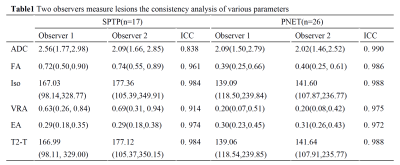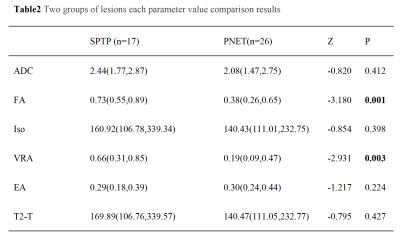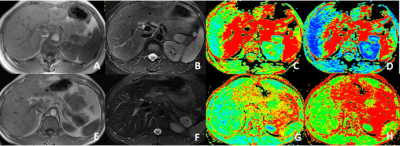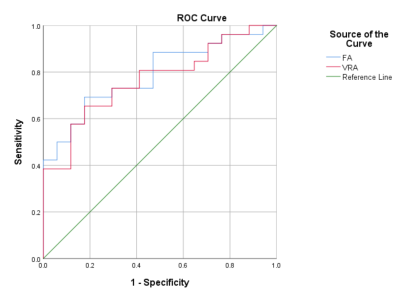4298
Differentiation of solid pseudopapillary tumor and neuroendocrine tumor of pancreas using DTI1School of Medical Imaging, Dalian Medical University, Dalian, China, 2Department of Radiology, Dalian Friendship Hospital, Dalian, China, 3Department of Radiology, the First Affiliated Hospital of Dalian Medical University, Dalian, China, 4GE Healthcare, MR Research China, Beijing, China
Synopsis
It is difficult to differentiate the solidpseudopapillary tumer of the pancreas(SPTP) from pancreatic neuroendocrine tumers (PNET), due to their similar imaging characteristics. There was significant difference in DTI quantitative parameters Fractional Aniso (FA) and Volume ratio Aniso (VRA) between SPTP and PNET. The results showed that the FA and VRA values of DTI sequence of SPTP were significantly higher than that of PNET. Therefore, DTI sequences may be an effective method to identify SPTP and PNET.
Purpose
To evaluate the diagnostic value of multiple quantitative parameters of DTI sequence in the differential diagnosis of solidpseudopapillary tumer of the pancreas(SPTP) and pancreatic neuroendocrine tumers (PNET).Introduction
SPTP and PNET are rare tumors in the pancreas. Although PNET is a blood rich tumor, about 41% to 49% of the tumors have no obvious enhancement after contrast enhanced scanning [1]. SPTP has malignant potential, and content in the lesions are mainly composed of solid components. In addition, some pancreatic neuroendocrine tumors may also show pseudocapillaries, which overlap with SPTP in histology. There are significant differences in invasion, treatment and prognosis between SPTP and PNET. While it is difficulties in the differential diagnosis of SPTP and PNET [2]. DTI is a magnetic resonance imaging technique for imaging the diffusion of water molecules in living tissues. This study aimed to assess the value of the DTI sequence to identify SPTP and PNET.Methods
17 cases of SPTP (4 male and 13 female)and 26 cases of PNET (9 male and 17 female) were enrolled in our study. MRI scan DTI sequences was performed on a 1.5T scanner (GE Signa HDXT). The DTI images were post-processed using FuncTool software on AW4.6 workstation. The average DC (ADC), fractional aniso (FA), isotropic image images (Iso), volume ratio Aniso (VRA), exponential attenuation (EA) and T2-weightial trace (T2-T) were obtained from DTI. All the function maps were performed by two radiologists, with 5-year and 10-year MRI diagnosis experience, respectively. Three circular ROIs were placed in the solid part of the lesions with an area of about 25-100 mm2(Figure 1). By Intra class correlation coefficients (ICC) were used to test the consistency of the measurements of two observers(ICC < 0.40,poor consistency; 0.40 ≤ ICC < 0.75 medium consistency; ICC ≥ 0.75,good consistency). Take two observers measured average statistics,the Independent t-test, Mann-Whitney tests and Kruskal-Wallis tests were used to carry out the comparisons among the groups, and receiver operating characteristic (ROC) curve was used to analyze the diagnostic efficiency.Results
The results of two observers were in good agreement (Table1). The value of Alph in SPTP was significantly higher than that in PENT. The values of FA and VRA on DTI in SPTP were significantly higher than those in PENT (P<0.05)(Table2). The AUC were 0.790 for FA(sensitivity69.2%,specificity 82.4%,Cutoff value ≥0.53 ) , 0.767 for VRA (sensitivity65.4%, specificity82.4%, Cutoff value≥0.28) (Figure 2).Discussion
At present, all PNET are considered to be very important differences in the risk of malignant tumor recurrence [3]. There was no significant difference in water molecule diffusion and microcirculation perfusion components between SPTP and PNET. SPTP is composed of solid area, pseudopapillary area and cystic area. The pseudopapillary structure formed by tumor cells in pseudopapillary area is a characteristic change of the disease. According to previous studies, SPTP pathological examination showed that tumor cells arranged orderly around the blood vessels with complex structure [4], so the FA and VRA of SPTP were significantly higher than those of PNET.Conclusion
FA and VRA based on DTI may be an effective method to differentiate SPTP from PNET. It may be a significance for clinical preoperative diagnosis and prognosis judgment.Acknowledgements
No acknowledgement found.References
[1] JEON S K, LEE J M,JOO I, et al. Nonhypervascular Pancreatic Neuroendocrine Tumors: Differential Diagnosis from Pancreatic Ductal Adenocarcinomas at MR Imaging-Retrospective Cross-sectional Study[J].Radiology.2017,284(1): 77-78.
[2] Serra S, Chetty R. Revision 2: an immunohistochemical approach and evaluation of solid pseudopapillary tumor of the pancereas [J].J Clin Pathol.2008, 61(11):1153-1159.
[3] Giandomenico V, Modlin I M, Ponten F, et al. Improving the diagnosis and management of neuroendocrine tumors: utilizing new advances in biomarker and molecular imaging science [J]. Neuroendocrinology, 2013, 98(1):16 -30.
[4] Diagnosis and treatment of 12 cases of solid pseudopapillary tumors of the pancreas ZHANG Jian-ping.NI Jia—lian,LIUXiao-ming.Department of Hepatobiliary Surgery,General Hospital of Jinan Military,Jinan 250031,China
Figures



